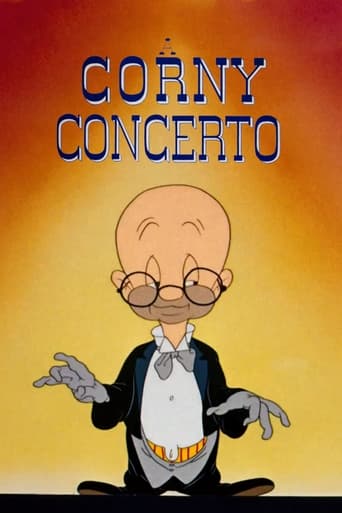TheLittleSongbird
A Corny Concerto, what can I say? Simply wonderful. Maybe not as hysterically funny as other Looney Tunes cartoons, but it is special to me for many reasons. A Corny Concerto isn't necessarily what you call hilarious, the funniest it comes to is Elmer's struggles with his loose fitting evening clothes though Porky and the pointer dog sobbing in Waltz time at Bug's "death" was funny too as was Bugs revealing his bra, tutu and pointe shoes and the stunned looks on Porky and Pointer Dog's faces. The animation though is wonderful, the wood in Tales from the Vienna Woods is beautifully rendered, but in terms of animation On the Beautiful Blue Danube was superior, with vibrant colouring particularly of the river itself. In terms of humour, Tales from the Vienna Woods is the better of the two, On the Beautiful Blue Danube is beautiful essentially but rather humourless in comparison. But what both segments have in common is that the music is outstanding. Johann Strauss II is rightly nicknamed "The Waltz King". Both pieces featured are fantastic and two of my favourite classical music pieces of all time, though I am more familiar with On the Beautiful Blue Danube. What impresses me most is how so much is fitted in in such a short running time without feeling bloated. This cartoon is fantastic, perfect for a classical music listener. 10/10 Bethany Cox
Lee Eisenberg
One of the great things about the classic Looney Tunes cartoons is how they introduced children to elements of culture. "What's Opera, Doc?" was probably their most famous cartoon involving opera, but there was also "A Corny Concerto". Elmer Fudd - having some trouble with his clothes - presents two short films with opera music in the background. And both come out very well.The one with Porky Pig hunting Bugs Bunny had ending that seems like it would have been a little risqué for 1943 (especially in a cartoon), but that's what makes these cartoons so good; they weren't afraid to push the limits. But the one with a black duckling - possibly Daffy Duck - is truly the highlight; but how could it not be, featuring "The Blue Danube"? One scene there gave the cartoon a real feeling of WWII.So, this is truly one of the classics. Up in that great animation studio in the sky, Mel Blanc, Bob Clampett, Chuck Jones, and that whole crew can take pleasure knowing that their work continues to impress us to this day.
movieman_kev
A parody of a great many Disney films, this short is simply fantastic and yet another feather in the hat of Bob Clampett (I know I seem to say that a lot, by Clampett was indeed a genius of animation). The music is magical, the animation is great, and although it might not be nearly as hilariously surreal as most of Clampetts other works, it's still very VERY good and I remain captivated by the short every single time I sit down to watch it. This animated short can be seen on Disc 4 of the Looney Tunes Golden Collection Volume 2 and also features an optional commentary by Micheal Barrier.My Grade: A+
alice liddell
From a story by the great Frank Tashlin, who would go on to make live action cartoons with the likes of Jerry Lewis, this is one of the best of the early bugs Bunnies. A parody of, ooh, everything from FANTASIA, BAMBI, the patronising populising of high culture, to an expression of genuine wartime anxieties, it proves how animation can offer truths more 'serious' films cannot.THe film is framed as one of those light classics concerts in which an inept conductor tries to explain the evening's programme, but is persistantly defeated by his cheap tux. His battle with his suit is slapstick fun, but also points to the ossification and impoverishment of music etc. by bourgeois respectability.Like FANTASIA in miniature, the short offers two pieces of animation, choreographed to classical music (both Strauss waltzes, nothing too heavy). THe first, Tales of the Vienna Woods, is the usual Bugs fiasco, where he is chased in a forest by Elmer and a big dog. THis is always fun, but is given added piquancy by the recreation of the forest, which has all the living richness of fairy tale illustrations, and by the film's movement, which is choreographed to the music's rhythm, and reaches delirious heights of hysteria.THe second, superior segment, The Blue Danube, features the young Daffy Duck, a lonely orphan bird who is rejected by a snooty family of swans. When the young chicks (or whatever) are abducted by a vulture, Daffy comes to the rescue, and is welcomed, if problematically, into the family.THese segments work on a number of levels. The pieces of music chosen are very famous sentimental impressions of nature - the cartoons reveal a vicious dog-eat-dog (or pig and dog eat rabbit) world of violence and terror. The vulture scenes are as chilling as anything in BAMBI.To say that nature is a self-generating abbatoir still lets us off the hook. But we must remember the year of the film's production, 1943. THe waltzes of Strauss might be among the most beloved fruits of the Teutonic imagination, but that imagination was currently engaged in the destruction of civilisation and nature across the continent. The scenes with the vulture rounding up the chicks have a very disturbing resonance.
BUt when Daffy rescues them, he turns terrifyingly into a being half shark, half fighter airplane. Contemporary US propaganda films showed the belated war effort as a noble and necessary calling; the questioning films only came when it was safe. BUt here was a cartoon tacitly admitting that the defence of civilisation involves a certain loss of that civilisation, a descent into the barbarity it seeks to exterminate. It is a brief moment, and there is a happy ending, but Daffy's reintergration at the end is not complete - this brilliant cartoon is unerringly prescient.




